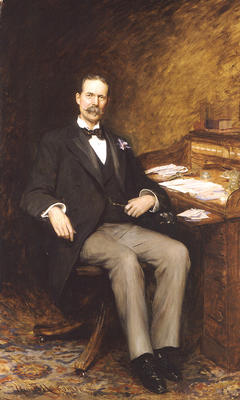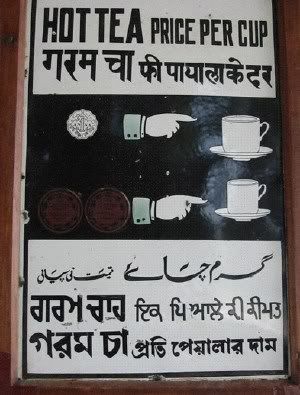I am sitting in front of my computer, listening to my favorite “Vital Signs” song:
Ye shaam phir nahi aaye gi
(This evening won’t come again)
I am smiling and sipping on my favorite Lipton Tea, while my fingers are keying in this moment in time.
All in all, a very coordinated effort is going on between my mind and soul. But take “Lipton tea” out of this equation and I’ll be left to a bored-to-death person listening to an archaic ancient group which historians remember by the name of ‘Vital Signs’ from early 90s and writing these disjointed words.
“Lipton Tea” – these two words stir deep memories in me. The earliest memory of Lipton tea in my life is drinking it with my maternal great grandfather (paR-nana).
 This portrait to the left, by the way, is of Sir Thomas J Lipton; not of my paR-nana!).
This portrait to the left, by the way, is of Sir Thomas J Lipton; not of my paR-nana!).
My great grand father was born in 1896 and lived till 1986. Until his last days he had a habit of making a cup of tea around 3 pm, and whenever I was around (which I always was) he used to pour some tea in my cup too. After that both of us would start watching PTV which started its daily transmission around 4 p.m. and sip on our tea.
Grandfather had migrated to Pakistan from India in 1947. He used to tell me all these great political stories from the old days, the Caliphate Movement, First World War, Quit-India Movement, Second World War, the Pakistan movement and finally the emergence of Pakistan.
He told me that until 1900s not many people in India knew about drinking tea (except for the tea growing areas of Darjeeling/Assam etc). British and whatever was left of East India Company at that time owned all the tea plantations in India, Ceylon (SriLanka), and Africa. Raw tea leaves were sent to London at Lipton Tea Company and after being processed and packed, was brought back to India and sold at exorbitant prices to the local people, on whose land the tea grew in first place.
Grand father told me that in the early 1900s Britishers used to set tea-stalls at street corners all over India and used to offer ‘free’ tea cups to Indians to promote the Lipton brand. In the beginning tea drinking was fashion at the high echelons of Indian society. Nawabs, and Rajas used to drink it in parties but within years its use grew all around and it even reached the far-flung villages of India.
 The accompanying picture to the right is a tablet that was placed at Bahawalnagar railway station in early 20th century. It is now placed in Pakistan Railway’s Heritage Museum at Golra Sharif near Islamabad. It advertises making of hot tea in 5 different written scripts; English, Devnagri, Urdu, Gormukhi and Bengali.
The accompanying picture to the right is a tablet that was placed at Bahawalnagar railway station in early 20th century. It is now placed in Pakistan Railway’s Heritage Museum at Golra Sharif near Islamabad. It advertises making of hot tea in 5 different written scripts; English, Devnagri, Urdu, Gormukhi and Bengali.
Grand father told me that drinking tea at 3:00 p.m. sharp was a British tradition brought to India. British used to drink tea two times a day en-mass. First time was at 3:00 p.m. (called ‘low tea’) and then again at 6:00 p.m. (called ‘high tea’). Low tea and high tea were the names given to this tea drinking habit just like breakfast-lunch-dinner.
The invention of the habit of afternoon tea is credited to Anna, Duchess of Bedford, who in about 1840 began taking tea with sandwiches and cakes to ward off “that sinking feeling” around four o’clock in the afternoon. Since the upper classes ate dinner fashionably late, Anna and her friends found that tea and small cakes were perfect to tide them over between lunch and dinner. Her idea soon became the fashion, and an English institution was born called ‘low tea’.
I guess grandfather and I kept the tradition alive in Karachi till 1986.
Last time I was in Pakistan I saw tea stalls and tea-shops at almost every street corner. It looks like the whole population now craves tea. And it is a part of our daily life. I won’t say its addiction, but would rather recite the famous sher by plagiarizing it a bit:
Chai se gharz-e-Nishat hai kis roo-siaah ko
Ik gona-e-bay-khudi mujhay har dum chahiyay
(Who the cursed-face needs pleasure out of tea
All I need is a place of solitude.)
Tea is also an essential part of Urdu literature. Shafiq-ur-Rehman who along with Mushtaq Ahmed Yousufi is perhaps the greatest humor writer of Urdu invented the term chuhaas which rhymes with pyaas(thirst) and means a thirst of tea.



















































Dear Sir/Madam,
I am Echo from Hunan Tea Co., Ltd of China, I am sincerely want to introduce our company for you. Our company is one of the three largest tea company of China,and the yearly amount of export reach to one billion. Our company export tea to all over the world, especilly Ameirica, Europe, Russia, Australia, Middle East Country and Africa. And our company tea have obtained many international certificates,such as EU IMO,the American NOP and the Japanese JONA and so on.
Our products: Black Tea, Green Tea, Organic Tea,Artistic Tea, Fruit Tea, Kongfu Black Tea, Black Broken Tea, Jasmine Tea,Brick Tea, Oolong Tea, Herb,Superfine Tea, Small-bag Tea, Instant Bag Tea,Tea Drink etc..
I look forward to establish a long-term cooperation with you and work for our mutual benefit. If there have any enquiry or order, please kindly contact me. We are warmly welcome you visit us!
Best regards and hope to hear from you~
PS: If you have done business with our company already, please kindly notice.Many thanks.
Echo
Sales Manager
Hunan Tea Co., Ltd of China
No.378 JieFang West Road, Tianxin District, hangsha City, Hunan Province,China 410002
http://www.xiangtea.com.cn/
hunan_tea@sina.com
Tel:0086-731-84457066
Fax:0086-731-82246766
Mobil:0086-13574824663
Msn: xuwen1113@hotmail.com
I enjoyed the facebook comment that said: Chai without Milk = Kala Paani = black water
Some more comments from the ATP Facebook Page:
– “I hate the teraditional milk tea. takes all the taste out of it. and its bad for health. so drink tea widout milk. spread the awarness”
– “really………i dont think sooo.. without milk its kala pani…”
– “Chai without Milk = Kala Paani = BLACKWATER? Hmmmmmm!”
– “Lighten up it is just a cup of tea!Just think of all the curry,chicken tikka and Balti ghosht the British are eating….then think of all the Masala Chai lattes drunk in the USA! I think we might be even by now in the food dept at least!”
– “i mean it . you can give up your 8 cups of tea habit in 4 5 days . and it will not effect you “
@Murree Hotels. Very good observation. I don’t know either why it says Lipton Tee instead of tea in first photo.
Do any of our learned readers know?
Could it be the ‘2 number’ lipton brand :)?
Sajjad, enjoyed your comment :) Yes, using ice-cream and yogurt in black-tea were the lowest points in my long history of tea drinking but as I said it was all done in the ‘alam-e-majboori’. See at both times I had boiled the tea (patti) but found out we had no milk left in the fridge. Getting milk required a long hike to the street corner to ‘Nagori milk center’. Because of perpetual laziness, which plagues many teenagers, I chose to try the short-cut of using yogurt and ice-cream. As I said earlier, both experiments failed miserably :)